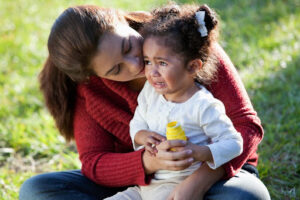What is stimming?
“Stimming” is a term which is often used to refer to self-stimulatory behaviors in children. These are repetitive behaviors that children engage in to stimulate their various sensory systems. Common forms of stimming may include hand flapping for increased proprioceptive (body awareness) input, rocking back and forth for increased vestibular (movement) input, lining up toys or staring at spinning objects for increased visual input, and humming or making other repetitive noises for increased auditory input. In extreme instances, stimming behaviors can be self-injurious (such as head-banging, self-scratching, or biting).
Self-stimulatory behaviors are often used by children to help them regulate their bodies and make them feel calmer or more engaged in certain situations. When children under-stimulated by their environments, they often participate in self-stimulatory behaviors for extra sensory input that may help them feel more engaged in the moment. When overstimulated, repetitive stimming behaviors can provide extra sensory input that many children find calming.
Is stimming bad for my child?
Self-injurious behaviors can be dangerous and may require you to intervene to physically stop the behavior before your child hurts him or herself. However, most self-stimulatory behaviors are simply socially inappropriate. In these situations, you can try to meet your child’s sensory needs through other activities, so he or she feels less of a need to seek out additional sensory information.
What can I do to help?
For children seeking out extra visual input, try playing with bubbles, balloons, or other toys which are easy to visually track. If your child seeks out additional proprioceptive input through hand flapping, you can try wheelbarrow walking, encouraging the child to sit on his or her hands, or providing hand squeezes to provide extra pressure in his or her joints. Try playing music, using a white noise machine, or playing with bubble wrap if your child engages in auditory stimming behaviors. If your child rocks or spins, try swinging in a blanket, climbing playground equipment, or rolling on the ground for increased vestibular input.
Natalie Machado, MS, OTR/L




